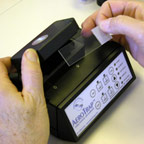MOLD/MICROBIAL SERVICES
Mold / Microbial Initial Site Visit

The first step is to have one of our Industrial Hygiene Consultants conduct an Initial Site Visit, which typically includes:
- Obtaining a detailed history and collecting necessary background information, including:
- Health, odor or other complaints
- Building construction and usage history
- HVAC system design
- History of operations or water intrusion events that might be contributing to the presence of mold
- Background on surrounding environment
- History of attempts to repair water intrusion and remediate mold
- Inspecting and moisture mapping of all accessible areas of immediate concern, plus utility spaces, heating, ventilation and air conditioning (HVAC) systems, exterior envelope of building, etc.
- Recording digital images of areas of concern for use in final report.
- Detailed moisture mapping using non, or minimally invasive, state-of-the-art moisture detection equipment. Moisture can be detected within wall cavities and other hidden areas to help focus investigation and remediation efforts. Thermal imaging is also available for large scale projects.
- Compiling careful field notes to document findings and facilitate useful and accurate reporting
- Collection of environmental samples based on inspection findings and resulting sampling strategy. Sampling may include:
- Direct surface samples of suspected of microbial growth. Samples are analyzed under a microscope to determine the genus of microorganisms present and the relative amounts. This method tests for all organisms present but does not differentiate between viable (live) and non-viable (dead) organisms.
- Culture surface samples are collected in culture media and incubated in the laboratory. This method identifies viable organisms to the species level. Such data is useful in cases where specific risks to human health are suspected.
- Spore trap air samples. Measured amounts of air are drawn onto a sticky slide. As in direct surface samples, slide is analyzed under a microscope to determine the genus of microorganisms present and the relative amounts.
- Culture air samples. Measured amounts of air are drawn onto a culture plate (Petri dish) and incubated in the laboratory. This method identifies viable organisms to the species level.
- Rapid (24 hour) bacterial cultures for key indicator organisms are available for fast response to sewerage-related investigations.
Back to Mold Assessment
|

